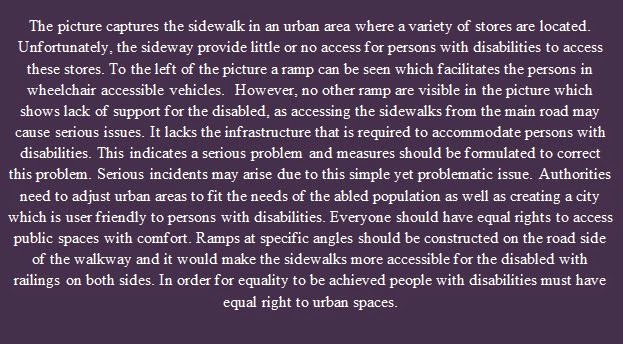The built form of the city and the planning and
policies that go along with it can shape lives in a positive light and then it
can shape lives in a negative light. One way is by excluding certain groups of
urban participants. Designers, planners, policy makers, architects etc have the
main influence on the built environment of a city and should put measures in
place to ensure that it reflects various practical and aesthetic designs (Hall
& Barrett, 2012). This is to guarantee that all needs are met. However,
researchers have outlined the issues faced “in the built environment by those
whose needs appear to not have been considered in the design of those spaces.” (Hall
and Barrett, 2012, p. 189) Therefore it seems that built environments embodies
divisions which casts light on the urban planning and policies employed. This
may be due to traditional ideologies and conventional ways of designing built
environments. The urban environment is mostly ‘man-made’ which means its use
and layouts reflect that of man. Moreover, the architectural design is built
around the able-bodied individual. Therefore, groups such as women, the elderly
and individuals with disabilities, are excluded because their roles and
activities within a city have not been considered. At present, modifications
have been made to planning designs and policies due to changing societies. However
limits still remain especially with respect to individuals with disabilities.
This is also a reflection in the era in which the
country is in such as industrial, modern, post-modern etc. Urban areas in
Trinidad and Tobago are mostly modern or post-industrial depending on the urban
space and the perspective. A modern city is characterised by its high rise
buildings which are seen as economic in nature. The modern city movement
occurred in the 19th and 20th century and during this
time Trinidad and Tobago’s main urban developments were taking place. During
this time much consideration was not given to certain groups as their roles
within urban areas were limited and as such they were not considered in the
design, as mentioned above. These traditional perspectives remained within the
modern culture and design and as time elapsed and such groups demanded rights,
changes were made. Presently most of the inclusive infrastructure can be seen
in post-modern societies.(Prince, 2008) Therefore as Mumford (1938) stated ‘cities are a
product of time’ and the transition and progress if nations influences the
Urban form and culture.
The pictures that follow show general built environment in Port of Spain and San Fernando.
 |
| Image 1 showing High Street, San Fernando (click to enlarge) Source: Jonathan E. Ramnarine |
 |
| (Click to enlarge) |
 |
| Image 2 showing Lower High Street, San Fernando (click to enlarge) Source: Jonathan E. Ramnarine. |
 |
| (Click to enlarge) |
 |
| Image 3 corner of Queen and Henry Street, showing Port of Spain (click to enlarge) Source: P. D'andra Nanda |
 |
| (Click to enlarge) |
According
to Michael J. Prince (2008) there are different
perspectives to analyse urban life in cities. In his article he outlines four perspectives;
two disregarded or did not consider individuals with disabilities while the
other two highlighted the need for inclusivity. Perspective three and four,
Excluded Others and Diverse Civic Publics, notes that it recognizes the needs
and rights of social groups which include people with disabilities in urban
areas. These perspectives are both post-modernists approaches as compared to
the first two perspectives which are more classic approaches that ignore these
social groups. Said approaches reflect a change in discourse in urban planning
and development where technical establishment of infrastructure in cites are
encouraged to promote equality and social harmony to all groups especially
persons with disabilities.
References:
Hall, T. & Barrett, H. (2012). Architecture. In
D. Bell & S. W. Williams (Eds.), Urban Geography (189-214). Abingdon, OX: Routledge.
Mumford, L. (1938). The culture of Cities. Harcourt, Bruce and Company.
Mumford, L. (1938). The culture of Cities. Harcourt, Bruce and Company.
Prince, M. J. (2008). Inclusive City Life: Persons with Disabilities and the Politics of Difference. Disability Studies Quarterly, 28(1), Retrieved from http://dsq-sds.org/article/view/65/65
Please tell us more about Prince (2008) - this is both good and relevant.
ReplyDelete